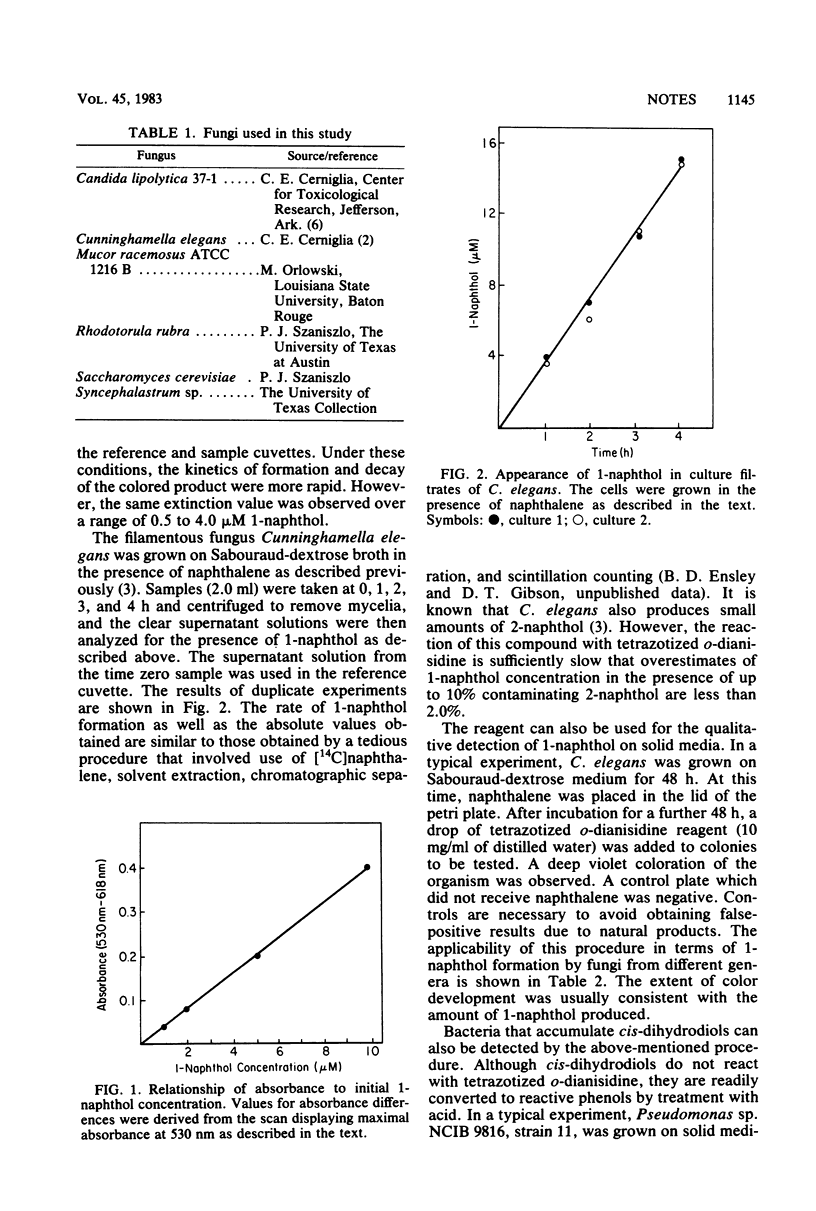Abstract
Tetrazotized o-dianisidine was used for quantitative measurements of the amount of 1-naphthol formed from naphthalene by fungi in liquid cultures. The reagent was also used to detect the accumulation of phenols and cis-dihydrodiols in fungal and bacterial colonies on solid media.
Full text
PDF



Selected References
These references are in PubMed. This may not be the complete list of references from this article.
- Cerniglia C. E., Gibson D. T. Metabolism of naphthalene by Cunninghamella elegans. Appl Environ Microbiol. 1977 Oct;34(4):363–370. doi: 10.1128/aem.34.4.363-370.1977. [DOI] [PMC free article] [PubMed] [Google Scholar]
- Cerniglia C. E., Gibson D. T. Metabolism of naphthalene by cell extracts of Cunninghamella elegans. Arch Biochem Biophys. 1978 Feb;186(1):121–127. doi: 10.1016/0003-9861(78)90471-x. [DOI] [PubMed] [Google Scholar]
- Cerniglia C. E., Hebert R. L., Szaniszlo P. J., Gibson D. T. Fungal transformation of naphthalene. Arch Microbiol. 1978 May 30;117(2):135–143. doi: 10.1007/BF00402301. [DOI] [PubMed] [Google Scholar]
- Cerniglia C. E., Perry J. J. Crude oil degradation by microorganisms isolated from the marine environment. Z Allg Mikrobiol. 1973;13(4):299–306. doi: 10.1002/jobm.3630130403. [DOI] [PubMed] [Google Scholar]
- Davies J. I., Evans W. C. Oxidative metabolism of naphthalene by soil pseudomonads. The ring-fission mechanism. Biochem J. 1964 May;91(2):251–261. doi: 10.1042/bj0910251. [DOI] [PMC free article] [PubMed] [Google Scholar]
- Ferris J. P., MacDonald L. H., Patrie M. A., Martin M. A. Aryl hydrocarbon hydroxylase activity in the fungus Cunninghamella bainieri: evidence for the presence of cytochrome P-450. Arch Biochem Biophys. 1976 Aug;175(2):443–452. doi: 10.1016/0003-9861(76)90532-4. [DOI] [PubMed] [Google Scholar]
- Gibson D. T., Hensley M., Yoshioka H., Mabry T. J. Formation of (+)-cis-2,3-dihydroxy-1-methylcyclohexa-4,6-diene from toluene by Pseudomonas putida. Biochemistry. 1970 Mar 31;9(7):1626–1630. doi: 10.1021/bi00809a023. [DOI] [PubMed] [Google Scholar]
- Gibson D. T., Koch J. R., Kallio R. E. Oxidative degradation of aromatic hydrocarbons by microorganisms. I. Enzymatic formation of catechol from benzene. Biochemistry. 1968 Jul;7(7):2653–2662. doi: 10.1021/bi00847a031. [DOI] [PubMed] [Google Scholar]
- McCann J., Choi E., Yamasaki E., Ames B. N. Detection of carcinogens as mutagens in the Salmonella/microsome test: assay of 300 chemicals. Proc Natl Acad Sci U S A. 1975 Dec;72(12):5135–5139. doi: 10.1073/pnas.72.12.5135. [DOI] [PMC free article] [PubMed] [Google Scholar]
- Messer W., Vielmetter W. High resolution colony staining for the detection of bacterial growth requirement mutants using naphthol azo-dye techniques. Biochem Biophys Res Commun. 1965 Oct 26;21(2):182–186. doi: 10.1016/0006-291x(65)90106-3. [DOI] [PubMed] [Google Scholar]
- Slaga T. J., Bracken W. M., Viaje A., Levin W., Yagi H., Jerina D. M., Conney A. H. Comparison of the tumor-initiating activities of benzo(a)pyrene arene oxides and diol-epoxides. Cancer Res. 1977 Nov;37(11):4130–4133. [PubMed] [Google Scholar]
- Stanier R. Y., Palleroni N. J., Doudoroff M. The aerobic pseudomonads: a taxonomic study. J Gen Microbiol. 1966 May;43(2):159–271. doi: 10.1099/00221287-43-2-159. [DOI] [PubMed] [Google Scholar]
- Thakker D. R., Yagi H., Lu A. Y., Levin W., Conney A. H. Metabolism of benzo[a]pyrene: conversion of (+/-)-trans-7,8-dihydroxy-7,8-dihydrobenzo[a]pyrene to highly mutagenic 7,8-diol-9,10-epoxides. Proc Natl Acad Sci U S A. 1976 Oct;73(10):3381–3385. doi: 10.1073/pnas.73.10.3381. [DOI] [PMC free article] [PubMed] [Google Scholar]


